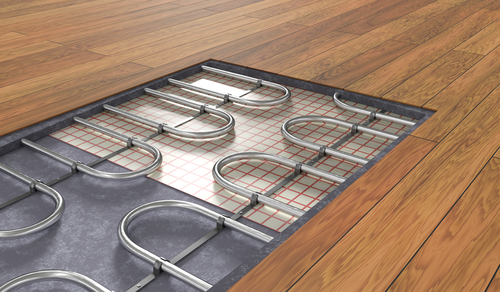Written on: January 2, 2020
 Radiant heating is growing in popularity because it’s a clean, quiet, efficient, dependable, and cost-effective way to heat your home in the winter. With radiant heating, heat comes from panels installed in floors, walls or ceilings. Steam or hot-water pipes are placed under the floor material, behind the walls or in the ceilings, delivering heat to the surrounding space, quietly and invisibly, in a constant, uniform way.
Radiant heating is growing in popularity because it’s a clean, quiet, efficient, dependable, and cost-effective way to heat your home in the winter. With radiant heating, heat comes from panels installed in floors, walls or ceilings. Steam or hot-water pipes are placed under the floor material, behind the walls or in the ceilings, delivering heat to the surrounding space, quietly and invisibly, in a constant, uniform way.
Believe it or not, radiant heating is one of the oldest forms of heating known to humankind. While the Romans are often given credit for creating radiant heat, in actuality, both archeology and research into ancient texts have proven that radiant heating came to be thousands of years before the Romans in Asia.
Thousands of years later, underfloor heating has evolved into one of the fastest-growing, most cost-effective and efficient ways to heat your house.
PM Engineer Magazine reports that radiant heating is growing in popularity each year in both new and retrofits across the U.S. And according to Scientific American, radiant systems transmit heat on average some 15 percent more efficiently than conventional radiators.
This article briefly explains what radiant heating is and what benefits it offers.
Radiant heating is a system of tubes that are installed under the floors, behind the walls or ceiling that are capable of warming up an entire house. The heat emitted by the tubing naturally radiates the room, warming all objects in it, including the floor, walls, ceiling, furniture and people. Radiant heating can also be installed outside your home, under the sidewalk or driveway to help melt ice and snow.
With radiant heating, panels are installed under a home’s floors, which heat up on command via electricity, hot water or air.
With electric radiant heating, electric cables are built into the floor, or a system using mats of electrically conductive plastic are installed on the subfloor. While this is a common radiant heating option for homeowners, it isn’t the most cost-effective due to the high cost of electricity.
Electric radiant floor heating only works if used in conjunction with a thick concrete floor to act as a significant thermal mass. This will help store the heat in the floor for a longer period of time.
Hydronic (liquid) radiant heat is the most popular and cost-effective heating system. With this type of radiant heat, tubing is installed in a pattern under the floor, and heated water is pumped from the home’s boiler through the tubing.
Newer hydronic systems allow for zoned heating, which controls the temperature in different parts of the house.
While less efficient than electric or hydronic systems, some radiant heating systems do use air heated panels. This type of radiant heating is usually combined with solar air heating systems. This type of radiant heating is not cost-effective for residential use.
In general, radiant floor heating can be used on any type of floor; hardwood, tile, carpet, and even concrete.
Radiant heating systems offer a ton of benefits to homeowners, including the following:
Radiant heating is more efficient than baseboard and forced-air heating because it eliminates duct losses. And, while traditional heaters are usually cranked to 149-167 Fahrenheit, floor radiant heating runs at 84 degrees Fahrenheit. For that reason, it consumes less energy.
Radiant heating systems are entirely quiet. Unlike forced-air systems, you won’t hear vents turning on and off all day, and no more clinging radiators either — just a silent, warm home.
People who suffer from allergies will appreciate radiant heat. No ductwork means that dust and other allergens won’t spread through air vents in your house, allowing you to breathe cleaner and easier.
Since warm air rises, radiant floor heating is the perfect way to deliver a consistent temperature throughout a home. The heat that the floors emit will travel upwards, thus warming the whole room to an even temperature.
Every time you turn up the thermostat in a forced-air heating system, your furnace sucks humidity out of your house. This can leave you with dry air, dry skin, and painful sinuses. Radiant heat will help humidity levels in your home.
Radiant heat is a flexible heating source as it can run off of: gas, oil, wood, solar and other sources or combinations thereof can feed radiant systems.
You don’t have to jump all in when it comes to adding radiant heat to your house. Instead, if you don’t want to install radiant heat throughout the house, you can choose to heat one or two rooms.
Radiant heating allows you to remove unsightly radiators and return vents on the floors and ceilings. With heated floors or walls, you can remove wall-mounted radiators and open the room up.
There is no need for ductwork for radiant heating to work properly. No ductwork means one less major thing to worry about during annual maintenance.
Radiant floor heating works with almost every single type of floor type: laminate, tile, wood, concrete, stone, and carpet.
Maybe the best perk of all, say goodbye to cold feet. Radiant heating means warm floors and warm feet around-the-clock, which is especially nice on those cold winter days when you’re stepping out of bed or out of the shower.
Households and commercial buildings account for nearly 40% of total U.S. energy use. As long as heating, cooling and lighting remain the single largest energy end-uses in a home, there will be an increased interest in finding and implementing energy-efficient building practices.
Radiant heating systems offer energy-efficient and cost-effective way to heat your home while saving hundreds of dollars on home heating bills.